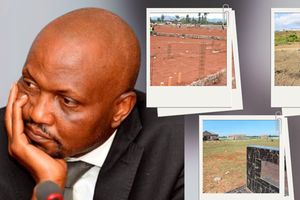Premium
Ruto and Raila promised ‘solutions’ may end up opening Pandora’s box

Azimio presidential candidate Raila Odinga (left) and his Kenya Kwanza counterpart William Ruto. Aside from the cash handouts and other goodies they are promising to dish out, the two are also seemingly competing on which of them will find more free land to distribute if elected president.
Aside from the cash handouts and other goodies they are promising to dish out, Deputy President William Ruto and Azimio la Umoja One Kenya Coalition party boss Raila Odinga are also seemingly competing on which of them will find more free land to distribute if elected president.
Some of the populist solutions they offer could incite tension rather than end the problems.
In what could cause a dramatic escalation of political rivalries, Dr Ruto has threatened to seize some of the expansive land holdings owned by President Uhuru Kenyatta’s household.
The Kenya Kwanza alliance flagbearer says his government will buy land from big owners to settle squatters.
Mr Odinga is pledging to settle the needy on large government farms.
Those campaign pledges within days of each other illustrate just how important emotive land issues become during the hunt for votes, with the main presidential candidates busy at every stop promising to solve them if elected.
Money to buy-off land
Dr Ruto talked on the issue at a May 24 campaign rally in Kwale County, where he said his government would set aside money to buy-off land, even resort to compulsory acquisition, from large landowners in the Coast to settle squatters.
“I am very much aware that land is a thorny issue in the Coast. We have very many squatters and because there is a lot of undeveloped land, we will buy it from absentee landlords to settle you,” Dr Ruto said, referring to landowners who have for ages provided for a thorny issue on coastal political, land and racial schisms.
Absentee landlord refers to colonists of Arab stock who after independence shifted to Oman, Yemen, Saudi Arabia and other lands in the Middle East where their forefathers hailed from, but retained ownership of vast tracts of land while the indigenous people remained squatters.
At the same meeting, outgoing Kilifi Governor Amason Kingi – who defected to Dr Ruto’s Kenya Kwanza from Mr Odinga’s Azimio la Umoja One Kenya Coalition – dismissed the latter’s announcement that he would task Mombasa Governor Hassan Joho with resolution of coastal land issues.
Hardly a neutral arbiter
Concern here is that Governor Joho is hardly a neutral arbiter, hailing from Arab stock and styling himself the “Sultan” – a reminder of historical domination by colonisers who reigned on the East African coast even before the arrival of the British.
The Deputy President used the occasion to hit out at Mr Odinga for supposedly having no solutions for local issues, accusing him of giving false promises on land to Coast residents.
During the event to unveil Narc Kenya leader Martha Karua as his running mate just over a week earlier in Nairobi, Mr Odinga had announced his nomination of Mr Joho as Cabinet Secretary for Lands if he forms the government in August, with a specific brief to solve the age-old coastal land issues.
Resettle squatters
And addressing a rally in Trans Nzoia County just three days after Dr Ruto spoke in Kwale, Mr Odinga promised to resettle squatters on Agricultural Development Corporation (ADC) farms.
He said once elected, his administration would redistribute government-owned land to the landless.
“To end the suffering of squatters, my government will distribute ADC land for their resettlement. We cannot live in a country in which some Kenyans have no land to grow food,” the Azimio la Umoja State House candidate told the meeting.
He used the occasion to hit out at Dr Ruto’s plan to purchase land for squatters, claiming that the DP is himself a beneficiary of ADC farms.
“My competitor plans to use public money to buy the same land he illegally acquired from the government and then pocket the millions of shilling from such deals,” Mr Odinga charged.
As the ping pong goes on, neither candidate has provided specifics on the amount of land available under his campaign promises, the number of would-be beneficiaries and how they would be identified, and the projected cost of these programmes.
In his campaign manifesto, Mr Odinga does not make specific reference to the plan for the division of ADC farms for the settlement of squatters.
Historical land injustices
In the chapter on land, he does make a promise to resolve “historical land injustices”, but without giving details.
The Azimio presidential flagbearer also promises to secure land tenure for squatters and the landless in the Coast and other parts of the country through bulk acquisition and resettlement.
The preamble to the chapter recognises that land was at the centre of the struggle for independence, and continues to be a source of conflict.
It is likely that when Dr Ruto releases his manifesto later this month, he will offer similar analysis and commitment but with little or vague prescriptions.
On their campaign trips across the country, Dr Ruto and Mr Odinga are addressing local land issues but avoiding discussion on the national land question and the problems that the founding fathers failed to address at independence.
Band aid solutions to localised issues may sometimes create more problems than they solve, as they are often geared towards satisfying grievances of the immediate audience rather than long term solutions.
They may at times even fuel tensions where local land issues revolve around conflict amongst different communities.
Kedong Ranch and Rose Farm
After Coast, for instance, Dr Ruto went to Narok County where he said his government would take over Kedong Ranch and adjacent Rose Farm and restore ownership to the Maasai community.
The Kenyatta family is believed to be a significant shareholder in the company that owns the massive 75,000-acre property, so it becomes difficult to dissociate the plan from an element of political payback.
President Uhuru Kenyatta has snubbed his deputy of two terms and instead thrown his weight behind the presidential bid of Mr Odinga, who in theory, is supposed to be in the opposition.
That area of Narok has been theatre of deadly conflict between the indigenous Maasai people and immigrant communities.
On his campaign tours of Narok and Kajiado counties, Mr Odinga regularly promises to address land injustices faced by the Maasai people, many of which happen to be linked to large-scale settlement land purchases by neighbouring communities, creating resentment that can often explode into violence.





